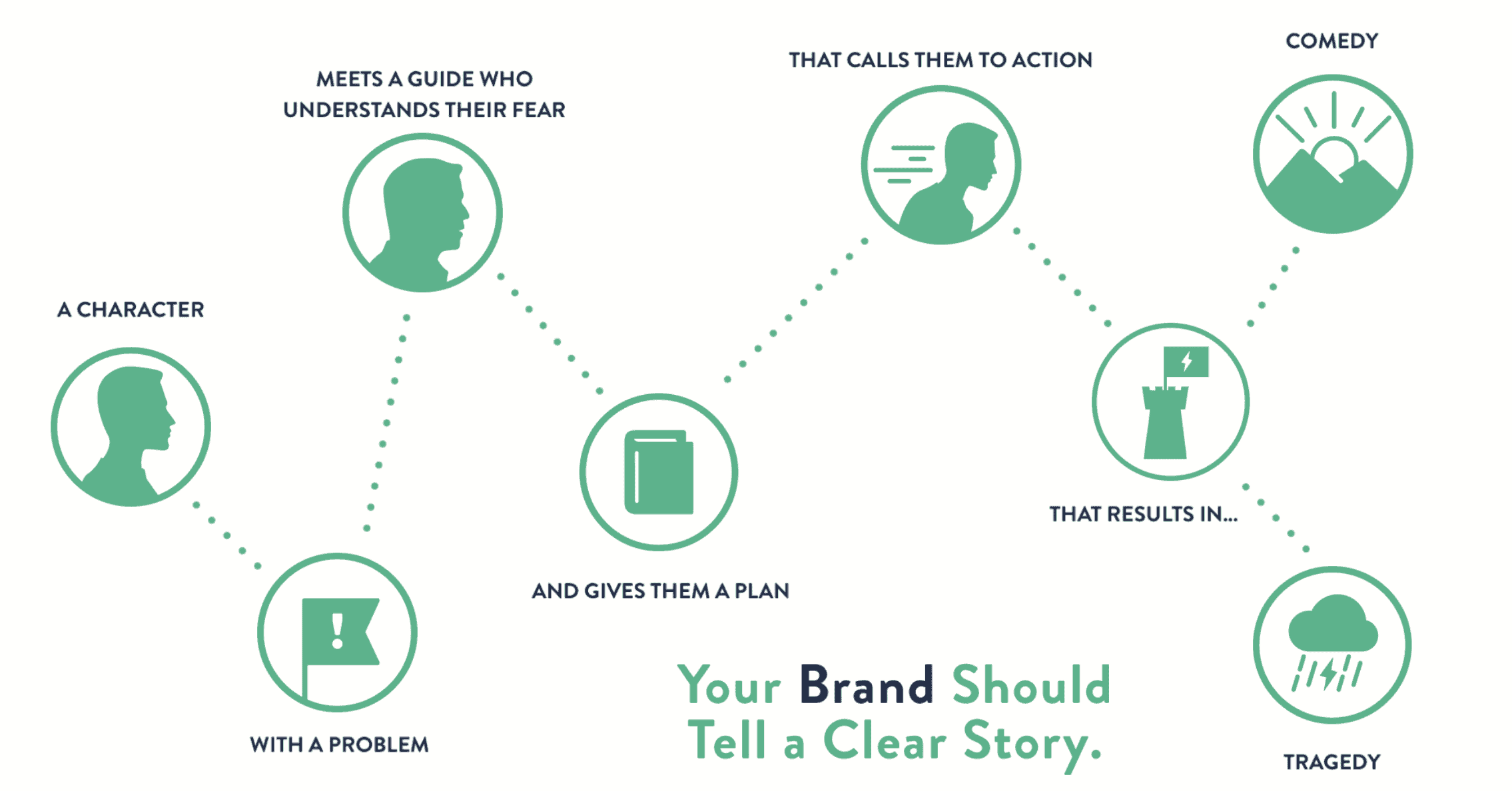One of today’s most asked marketing questions is, “What is the StoryBrand Framework and how does it help grow my business?”.
The answer begins in 2016, when Donald Miller released a book titled, “Building A StoryBrand: Clarify Your Message So Your Customer Listens”. And it wasn’t long before the book was climbing to the top of the Wall Street Journal bestsellers list. Four years later, over 10,000 companies have now had their message clarified by the StoryBrand Framework.

Any of these 10,0000 companies will tell you that before implementing the StoryBrand Framework, their marketing message was primarily centered around their company, not their prospective customer. And unless you want to sell more to your employees, telling a story about your company is a sure-fire way to waste money on marketing.
“And unless you want to sell more to your employees, telling a story about your company is a sure-fire way to waste money on marketing.”
Instead, by implementing the StoryBrand Framework, these companies tweaked their marketing message to make their customers feel more understood (and more likely to make a purchase).
Want to become a company that empathizes with your customers and compels them to buy? Here’s more on what the StoryBrand Framework is and how you can use it to grow your business.
What is the StoryBrand Framework?
The StoryBrand Framework is a seven-part formula that helps companies communicate clearly and effectively using the power of story. If implemented correctly, it makes your audience feel understood and compels them to take action.

Here are the seven parts of the StoryBrand Framework:
- A hero (your customer) wants something.
- There’s a problem in the way.
- There’s a guide (your company) that can help them.
- The guide offers a plan to help the hero get what they want.
- The guide calls the hero to action.
- The guide shows the hero what success will look like if they answer the call to action.
- The guide shows the hero what problems they will face if they don’t answer the call to action.
Does this sound like a story you’ve heard before? It should. The StoryBrand Framework is the same storytelling structure that sells millions at the box office and keeps an audience glued to their seats for hours on end. And it will work for your business.
“The StoryBrand Framework is the same storytelling structure that sells millions at the box office and keeps an audience glued to their seats…”
Why is the StoryBrand Framework So Effective?
Here’s the problem. Your customer’s brain is burning calories every second that they’re listening to you. If you aren’t communicating clearly, this is an intellectual workout that becomes more demanding than beneficial. And then your customers disengage.
On top of that, Americans are bombarded with more than 4,000 marketing messages every single day. As consumers, we’re constantly sifting through information and trying to determine what we need to pay attention to.
“Americans are bombarded with more than 4,000 marketing messages every single day.”
The solution? According to StoryBrand, story is the most powerful tool on the planet for organizing information and captivating the human brain. It’s as simple as this: story works because that’s how humans work.
This concept is as old as time, yet more valuable today than ever before.
How Should You Use the StoryBrand Framework?
There’s no doubt that story is your company’s best shot at engaging your audience. The question is, how do you take the StoryBrand Framework and apply it to a business—like a cybersecurity company or local university?
Follow these five guidelines if you want use the StoryBrand Framework effectively:
- Position your customer as the hero and your company as the guide. Most companies get this backward. (And explains why their marketing messages are being ignored.)
- Get to know your audience. What is their day-to-day like? What are their habits and hobbies? What problems are they facing? You need this information if you want them to connect with your message.
- Clarify what you offer customers. Be able to easily say what your business does and how it can lead customers out of a problem and into a solution.
- Imagine what your audience’s life would look like if they solved their problem. Depict this in your marketing collateral and show your customers a future, successful version of themselves.
- Implore your audience to take action. Be direct. And remember, this will ultimately lead to a better life for your customers (if they listen).
The Takeaway
At the beginning of George Clooney’s acting career, he was struggling to land a role. Looking back at this time, he said all he wanted was the casting people to like him. When they didn’t, he was offended and blamed the film industry for not realizing how talented he was.
But after several failed auditions, he had a revelation—he wasn’t the only one with a problem. Casting is a challenge for producers and directors too, and they certainly don’t want to sit through auditions all day. They want the next person to be the right person. Clooney then started to understand that auditions were an opportunity to solve a caster’s problem, not his. And the rest is history.
“Clooney then started to understand that auditions were an opportunity to solve a caster’s problem, not his.”
While your competitors are coming across as insecure to your audience, use the StoryBrand Framework to show your customers how you can solve their problems.
Then they’ll listen to every word you say.
(P.S. Want to learn more about this framework? Download our e-book for a more in-depth breakdown of this storytelling formula. )
